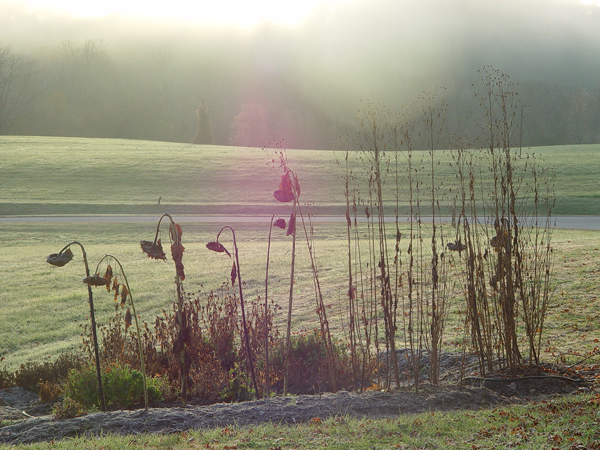
29 Nov Late November Landscape
The cast of color has changed greatly from earlier this month, from the hillsides around us which showed mostly the deeper russet reds and burnt oranges. A few individual trees around the Folk School campus still glowed with vibrant oranges and yellows. In this glorious fall, those who were here to study and play were surrounded by landscape colors changing and twirling to the ground every day. Work-study students prepared the garden for wintering over. November brought the mists again when the rains came. Patches of sunlight on the mountainsides revealed soft grays topped with pale burnished golds polished by the sun.
Then by mid-November during “Recycle It” Week, the garden had a full selection of fall greens – turnips, Chinese, and mustard, for the finest in seasonal fare. This of course was how our ancestors ate before the advent of grocery store chains and transfer trucks! A traditional part of Appalachian culture has been the trait of resourcefulness. Working not only with what nature provided, but also with the materials close by and at hand. Mountain people were always living this way – long before anybody had invented the word “recycle”.
It was in this spirit that the blacksmiths in Lyle Wheeler’s Bring Out Your Inner Ironmonger class searched for cast off metal items from other studios and the Maintenance Department. The nearby flea market also provided some useful broken gadgets and tools as well. Don’t even think about going to the hardware store, because in this class you make some of your own tools, too! So with more than enough metal and ideas for a week, the students began with the number one blacksmithing basic: how to build and maintain a forge fire.
The Blacksmithing Shop is fully equipped, even with un-everyday things like an Electrode Stabilizing Oven and three different kinds of welders. Depending on your fancy, of welding steel-to-steel or cast metal to steel. The fascinating thing I never understood before is that metal, under certain conditions, can actually move like potter’s clay. Lyle demonstrates the basics of hammering out a simple leaf shape with a stem. Flattening and moving the shape with heat and various tools, an iron hammered leaf appears! Once again, we see that it’s all about knowing how to use the tools you’ve got! And that is how a lawnmower blade turns into a yard turkey and a fly press turns marks into a key holder or candlestick.
When you suspend your disbelief and let your creativity overflow ordinary boundaries, like children do, you too will see iron move like clay and broken objects reappear as Art!




No Comments